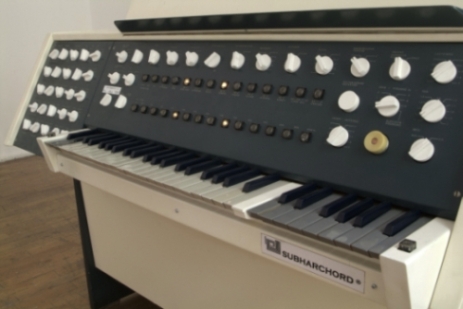
Raymond Scott was a jazz bandleader (his band did the music for the Bugs Bunny cartoons) and was famous for adapting classical pieces into jazz format. Scott, however, was also an audio engineer who founded his own company in 1946—Manhattan Research. He patented various electronic devices. Above is the electronium which he patented in 1959. It has no keyboard but was designed to be an “instantaneous composition/performance machine.” This machine so impressed Berry Gordy that he hired Scott as director of electronic research and development at Motown. The electronium is not functional these days but it was bought by Mark Mothersbaugh of Devo who hopes to get it working again.

The Clavivox which Scott patented in 1956. This device is also heard on “Cindy Electronium.” One of Scott’s assistants in the 50s was a young Bob Moog who was overwhelmed by Scott’s collection of electronic gadgetry for making music. “When I first worked for Raymond,” Moog recalled, “he had a large laboratory in the basement of his mansion. The room was filled with rack upon rack of relays, motors, steppers and electronic circuits. He would set it going, then go around and adjust various things to change the patterns that were being produced. I’d never seen anything like it.” That’s because there wasn’t anything else like it. Scott’s electronic instruments were unique, made and designed by him.

The Subharchord, invented in East Germany in 1962 by Ernst Schreiber, it was basically a keyboard version of West Germany’s Mixtur-Trautonium in that it played subharmonics rather than harmonics (hence its name). The Subharchord was more versatile than the Trautonium.

The keyboard of the Subharchord. This instrument was nearly lost to us until it was rediscovered by a Berlin musician named Manfred Miersch who publicized his find which generated interest. The Subharchord was restored to service.
In the early 60s, there were artists performing with oscillators and tape. One of the foremost of these was Tod Dockstader who did the sound FX for
Tom & Jerry. He was combining musique concrète with electronically generated sounds to come up with very compelling pieces. His 1961 piece,
Apocalypse II, is a good example. Dockstader takes the sound of a creaky-hinged door and turns it into something completely mind-warping (you should hear it through surround sound speakers).
Tod Dockstader - Apocalypse Part II.wmv - YouTube